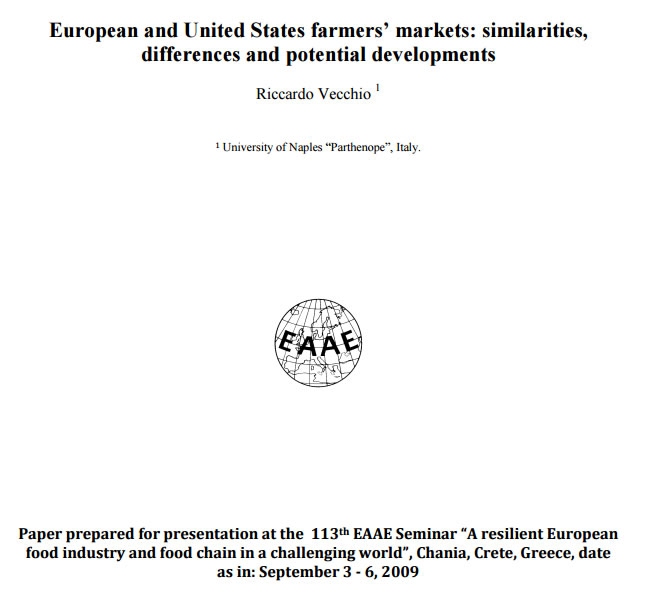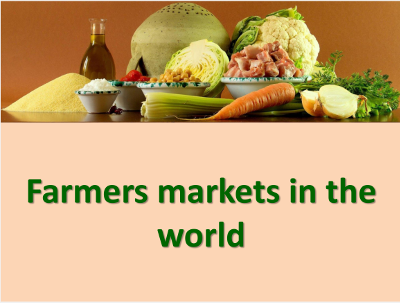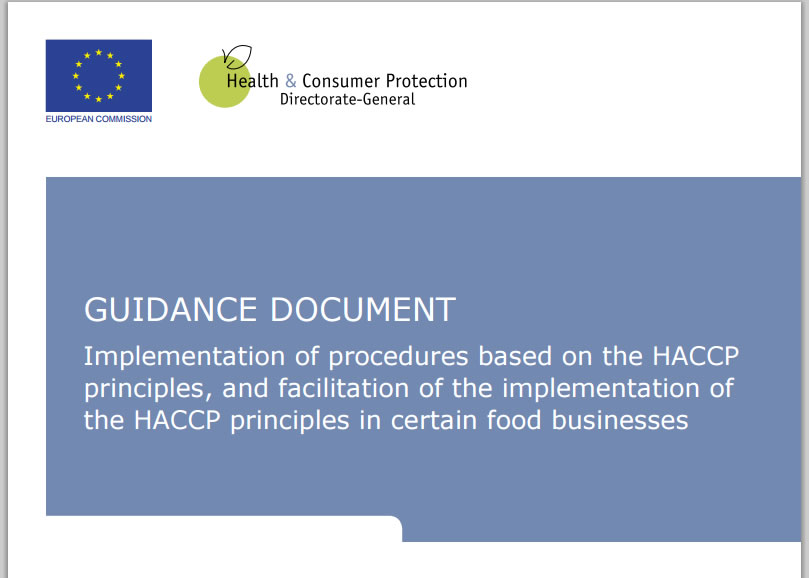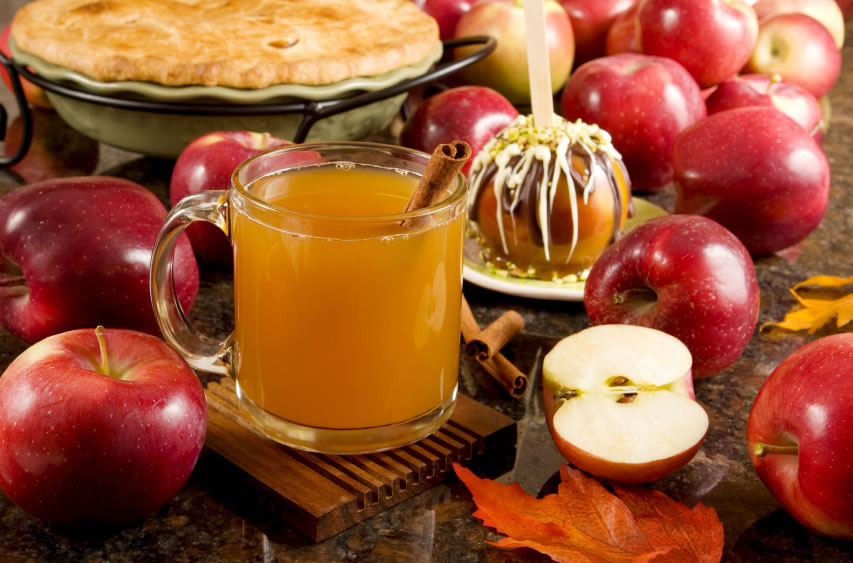Direct selling
See Module 1 Unit 4 for preliminary info on this topic
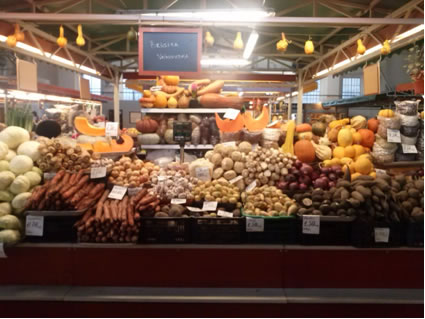
The EU Directive on Consumer Rights (Directive 2011/83/EU) defines Direct Selling as contracts concluded between traders and consumers with the simultaneous physical presence of the trader and the consumer, in a place which is not the business premises of the trader.
Selling directly to consumers could be an opportunity for small producers.
It allows you to eliminate the ‘middle man’ and sell direct to customers, increasing the possibility of receiving a higher return. Direct selling is also a great way to sell specialized products or products with volumes too low to sell through conventional channels. It also provides an opportunity to obtain customer feedback or experiment with alternative products.
There are many benefits from direct selling including :
- increased and more stable farm incomes
- increased jobs and wealth retention for local economies
- improved access to fresh produce
- enhanced accountability and choice
- reduced vulnerability to contamination and food safety concerns
- given the smaller distribution range of foods
- diversified and sustainable production
- lower energy use due to less transportation and less contribution to climate change.
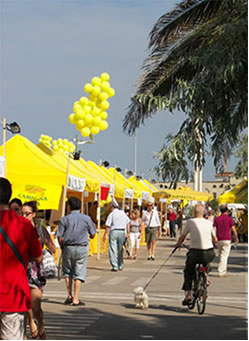
Watch these videos:
A wide range of farm businesses can be considered to be engaged in local food. These include:
- direct-to-consumer marketing
- farmers’ markets
- farm-to-school programmes
- Community-supported agriculture
- Community gardens, school gardens
- food hubs and market aggregators
- mobile slaughter units
- Farm sales/stores
- Points in large scale distribution stores
What is Direct Selling?
Why should a farmer consider Direct Selling as an opportunity?
How does it work?
Farmers' markets at EU level: some benchmarking examples
Recently, the EU Commission in its regulation no 807/2014 of 11 March 2014 on rural development for the new CAP programming period recognizes the importance of short supply chains and local markets: "Short supply chains and local markets in relation to which support may be given should be specified. In order to allow for a clear demarcation between the two, the number of intermediaries should be used as a criterion defining short supply chains whereas kilometric distance from the farm, taking into account specific geographic features of the area concerned, should be the criterion defining local markets, unless a convincing alternative criterion is presented. Cooperation among small operators should be sharply focused on overcoming the general disadvantages caused by fragmentation in rural areas. Therefore, it should be limited to microenterprises and natural persons who are about to start up a microenterprise at the moment of applying for support. In order to ensure a coherent approach in the implementation of the cooperation measure only promotion activities related to short supply chains and local markets should be supported under that measure."
The CAP Communication Awards are aimed at showcasing the very best communication initiatives related to the Common Agricultural Policy in the three categories of Communication to Stakeholders, Communication to the Public and Innovative Communication.
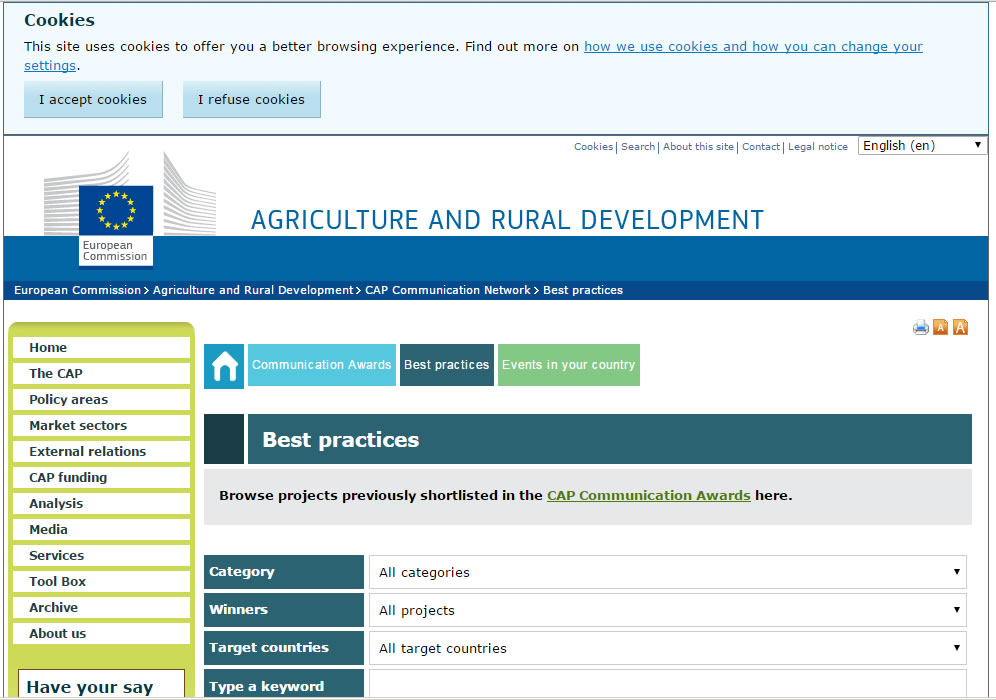
Read: Best practices
Among the best initiatives seen in 2012-2014, some are related to Farmers' markets and are summarized below:
Farmers' Markets in Apulia Region
Food production project in Apulia region Italy aims to promote short supply chains and help rural development via agricultural diversification. The Farmers’ Market project aims to promote the importance of a short supply chain or a closed-circuit in food production, through “farmers’ markets” as a business activity. This encourages the direct and social relationship between farmers and consumers, produces a cut in final product pricing, as well as providing a way to diversify the farmer’s income, through multi-functionality in agriculture.
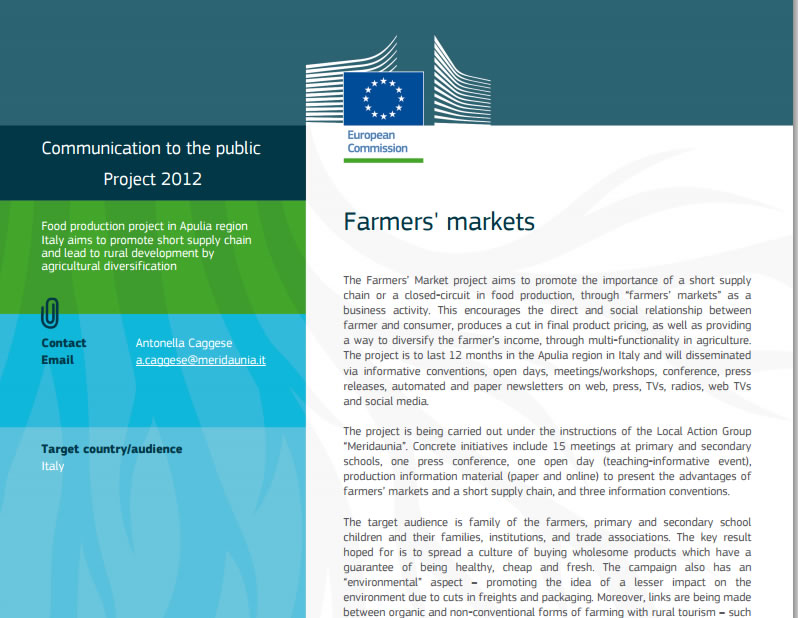
Farmers markets to raisie awareness of Common Agricultural Policy support for sustainable agriculture
EU accession was seen as a threat in Romania to local food production and sales, threatening markets for small-scale farmers and local food for consumers. The objective was to help the Romanian general public understand how the CAP is not a threat to Romania’s traditional rural culture, but is a potential support.
Three high-profile markets were used as a tool for communicating information. As a result, the message was passed directly to those people who attended the three farmers markets, by personal contact with project staff and small-scale food producers. The views of Romanian small-scale producers, and of consumers, have altered as a result of this campaign. Citizens feel more confident to sell and to buy local food directly than before. And the EU is recognised as supporting local sales and short food chains.
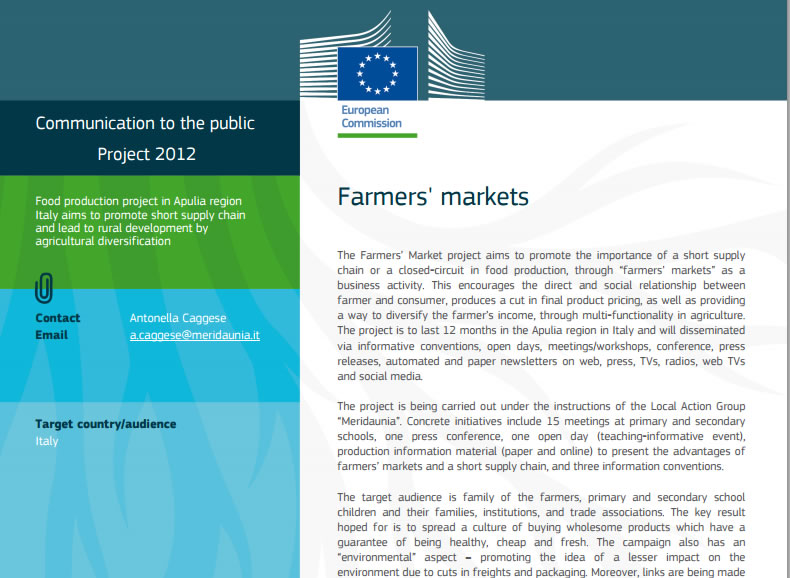
Know what you are eating, know where your food comes from
Establishing farmers markets to show EU supports local agriculture, employment and sales in rural areas. Before Romania became a part of the EU, it was seen as a threat to local food production and sales by many Romanians. Three traditional farmers markets were organised using modern branding and promotional tactics in order to attract both consumers and the media. The news stories emerging from coverage of the markets spread the message that the EU supports local and sustainable agricultural employment in rural areas and sales of local produce. Know your food, know where it comes from’ was a successful slogan. Posters and banners were designed to show that direct sales and local traditional food are also innovative in the current policy context. The markets continue today as they are sustainable, and the national media maintains an interest.
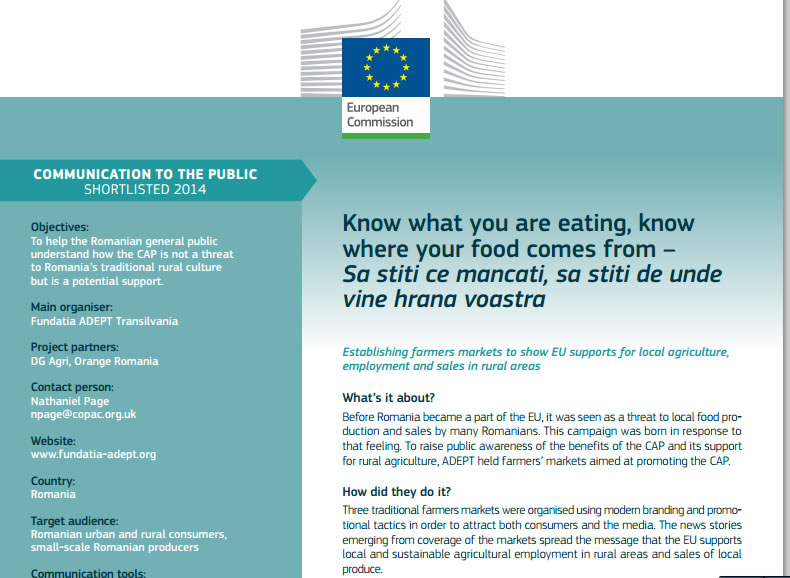
Is there a unique model for Farmers Markets?
Market Definitions:
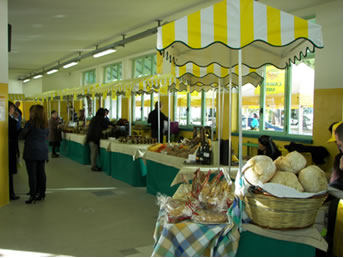
- a place where buyers and sellers convene for the sale of goods
- an event or occasion, usually held at regular intervals, where people meet for the purpose od selling merchandise
- a store for the sale of food
- a shop that sells particular merchandise
- a meeting of people for selling and buying
- the field of trade or business
The word Market comes from the Latin market mercatum, from past participle of mercari to trade, deal in, buy.
For Greeks, Etruscans and Romans, it was a place of knowledge and encounter, in Italy during medieval times, it became a place of representation and competition opportunities in which people measured the strength of the countryside, the peasant farms, the quality of the land and the expertise of farmers.
No single formula for a Farmers Market exists. Markets will differ depending on the context in which they occur and the consumer segment to which they are addressed. However, some elements seem to be common to all or most Farmers Markets:
- Goods are transported only short distances;
- Ways exist for consumers to verify the quality and origin of food products;
- Activities involving food traditions are included in the markets;
- For the most part, markets are weekly events;
- The clientele is highly loyal; and
- Groups organize cooking lessons and nutritional awareness sessions in the markets or through them.
Farmers Markets around the world are often held up as a key alternative to less sustainable conventional food production systems. Farmers Markets are probably the oldest and most common type of direct marketing. Because they are able to bring food producers and consumers together they exemplify an alternative food network. Farmers Marketss are the most extreme form of a short food supply chain for both time and distance. In the past two decades, they have offered a number of consumers their first experience in re-localized and re-personalized forms of exchange.
Source: A. Cavicchi; Rocchi B, New trends of sustainable consumption: the farmers’ market as a business imperative for the reeducation of consumers, in WANKEL C.; STONER J. Global Sustainability as a Business Imperative; New York, Palgrave-McMillan; pp. 239 - 254
Watch this video on How to sell at Farmers Markets
What are the hygienic and sanitary standards?
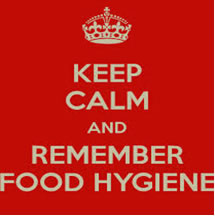
Anyway, these are basic recommendations that customers can follow to ensure that the farm-fresh food is safe and that you could report on the shelf as an added value service.
Before and after preparing fresh produce:
- wash your hands for 20 seconds with warm water and soap
- wash fruits and vegetables thoroughly under running water just before eating, cutting or cooking. We don’t recommend washing fruits and vegetables with soap or detergent or using commercial produce washes
- if you plan to peel the produce before eating, it is still important to wash it first. Any bacteria present on the outside of items like melons can be transferred to the inside when you cut or peel them
- refrigerate cut or peeled fruits and vegetables within two hours after preparation
Watch these videos
Markets provide a suitable environment for farmers and food producers to sell direct to customers products of farm-origin and associated value-added or processed artisan food.
Be it organic, bio-dynamic or conventional production systems, the fresh produce available at farmers’ markets continues to attract a loyal and enthusiastic following.
A regular stall at a farmers' market requires very little capital investment. You will require a table, shelter, packaging and signage to identify your business name, products and their price.
Costs may include stall fees, equipment, packaging, public liability insurance, sales labour, transportation and storage. Advertising costs are commonly low as it is done en-masse by the farmers' market you are participating in and is usually included in your stall fees.
Successful markets TIPS:
- Choose busy or central areas
- good integrity (e.g. sell only locally produced food)
- have an effective market manager to promote the market and reinforce the rules
- have a good number of stalls and a good mix of products.




